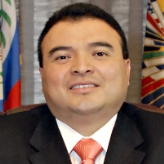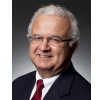Belize
 Méndez, Néstor
Méndez, Néstor
- Table of Contents
- News
- Overview
- Basic Information
- History
- Newspapers
- History of U.S. Relations with Belize
- Current U.S. Relations with Belize
- Where Does the Money Flow
- Controversies
- Human Rights
- Debate
- Past Ambassadors
- Ambassador to the U.S.
- Embassy Web Site in the U.S.
- Comments
- Leave a comment
U.S. Ambassador to Belize

The next ambassador to the Central American nation of Belize—the only country in the region where English is the official language—will be a retired jurist from California. Nominated July 8, Carlos R. Moreno, who served ten years on the California Supreme Court, would succeed Vinai K. Thummalapally, whose service started in August 2009.
Born November 4, 1948, in Los Angeles, Moreno grew up in a Spanish-speaking home in the small community of Solano Canyon in Elysian Park, not far from Dodger Stadium. Although his Mexican immigrant mother arrived in the U.S. with few skills and no resources after his father’s death, Moreno graduated public high school, earned a B.A. in Political Science at Yale University in 1970 and a J.D. at Stanford Law School in 1975.
Moreno began his legal career in 1975 as a deputy city attorney with the Los Angeles City Attorney’s office, prosecuting criminal and civil consumer protection cases. Leaving public service for private practice, Moreno worked at the firm of Mori & Ota (which became part of Kelley, Drye & Warren) from 1979 to 1986, representing clients in the firm’s general commercial litigation practice.
Moreno’s judicial career began in the fall of 1986, when California Gov. George Deukmejian (R) appointed him to the Municipal Court, Compton Judicial District, where Moreno handled criminal matters and supervised the court’s civil department. After seven years, in October 1993, Gov. Pete Wilson (R) elevated Moreno to Los Angeles County Superior Court, where he presided over felony trials for nearly five years.
Moreno became a federal judge when he was nominated by President Bill Clinton to the U.S. District Court for the Central District of California, where he served from February 1998 to mid-2001.
Nominated by Gov. Gray Davis (D), Moreno served as an associate justice of the Supreme Court of California from October 18, 2001 until his retirement on February 28, 2011. Moreno won electoral confirmation in November 2002 to finish the term of his deceased predecessor, Justice Stanley Mosk, and again in 2010, when voters confirmed him to a full 12-year term.
In May 2009, it was reported that Moreno was being considered by President Barack Obama as a possible successor to Justice David Souter on the U.S. Supreme Court, but the President chose Judge Sonia Sotomayor instead—on the same day Moreno cast the California high court’s only vote to overturn anti-same sex marriage Proposition 8.
Since 2011, he has been a counsel at Irell & Manella LLP.
Moreno has served as President of the Mexican American Bar Association, and on the Board of Visitors of Stanford Law School and the Board of Governors of the Association of Yale Alumni. He is a Director of the Arroyo Vista Family Health Center.
He and his wife, Christine, an artist, have two children, Keiko and Nicholas.
-Matt Bewig
To Learn More:
Carlos Moreno, California High Court Justice, is Raising his Profile (by Maura Dolan, Los Angeles Times)
more
 Méndez, Néstor
Méndez, Néstor
Comments
U.S. Ambassador to Belize

The next ambassador to the Central American nation of Belize—the only country in the region where English is the official language—will be a retired jurist from California. Nominated July 8, Carlos R. Moreno, who served ten years on the California Supreme Court, would succeed Vinai K. Thummalapally, whose service started in August 2009.
Born November 4, 1948, in Los Angeles, Moreno grew up in a Spanish-speaking home in the small community of Solano Canyon in Elysian Park, not far from Dodger Stadium. Although his Mexican immigrant mother arrived in the U.S. with few skills and no resources after his father’s death, Moreno graduated public high school, earned a B.A. in Political Science at Yale University in 1970 and a J.D. at Stanford Law School in 1975.
Moreno began his legal career in 1975 as a deputy city attorney with the Los Angeles City Attorney’s office, prosecuting criminal and civil consumer protection cases. Leaving public service for private practice, Moreno worked at the firm of Mori & Ota (which became part of Kelley, Drye & Warren) from 1979 to 1986, representing clients in the firm’s general commercial litigation practice.
Moreno’s judicial career began in the fall of 1986, when California Gov. George Deukmejian (R) appointed him to the Municipal Court, Compton Judicial District, where Moreno handled criminal matters and supervised the court’s civil department. After seven years, in October 1993, Gov. Pete Wilson (R) elevated Moreno to Los Angeles County Superior Court, where he presided over felony trials for nearly five years.
Moreno became a federal judge when he was nominated by President Bill Clinton to the U.S. District Court for the Central District of California, where he served from February 1998 to mid-2001.
Nominated by Gov. Gray Davis (D), Moreno served as an associate justice of the Supreme Court of California from October 18, 2001 until his retirement on February 28, 2011. Moreno won electoral confirmation in November 2002 to finish the term of his deceased predecessor, Justice Stanley Mosk, and again in 2010, when voters confirmed him to a full 12-year term.
In May 2009, it was reported that Moreno was being considered by President Barack Obama as a possible successor to Justice David Souter on the U.S. Supreme Court, but the President chose Judge Sonia Sotomayor instead—on the same day Moreno cast the California high court’s only vote to overturn anti-same sex marriage Proposition 8.
Since 2011, he has been a counsel at Irell & Manella LLP.
Moreno has served as President of the Mexican American Bar Association, and on the Board of Visitors of Stanford Law School and the Board of Governors of the Association of Yale Alumni. He is a Director of the Arroyo Vista Family Health Center.
He and his wife, Christine, an artist, have two children, Keiko and Nicholas.
-Matt Bewig
To Learn More:
Carlos Moreno, California High Court Justice, is Raising his Profile (by Maura Dolan, Los Angeles Times)
more






Comments